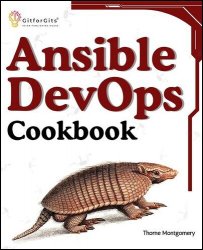Ansible DevOps Cookbook: End-to-end automation solutions including setup, playbooks, cloud services, CI/CD integration
- Добавил: literator
- Дата: 14-07-2024, 08:01
- Комментариев: 0
 Название: Ansible DevOps Cookbook: End-to-end automation solutions including setup, playbooks, cloud services, CI/CD integration, and ansible tower management
Название: Ansible DevOps Cookbook: End-to-end automation solutions including setup, playbooks, cloud services, CI/CD integration, and ansible tower managementАвтор: Thorne Montgomery
Издательство: GitforGits
Год: 2024
Страниц: 449
Язык: английский
Формат: pdf, azw3, epub, mobi
Размер: 10.1 MB
A collection of over seventy-five solution-focused recipes, "Ansible DevOps Cookbook" will show you how to use Ansible to fix problems, simplify operations, and boost the efficiency of your DevOps practices. You should start by creating an efficient inventory system, configuring control and managed nodes, and setting up your Ansible environment. You can implement effective solutions such as handling more complex playbook techniques, such as working with variables, facts, conditionals, loops, and more. You will be skillful to organize playbooks and create reusable automation with Ansible roles. You can increase your automation capabilities by accessing community-driven content through Ansible Galaxy, which is explained in the book.
When it comes to cloud integration, the book goes into great detail on how to automate deployments on AWS, Azure, and GCP. These recipes show how to use Ansible modules for managing and provisioning cloud infrastructure, so you can manage resources efficiently and ensure high availability and performance. Ansible, Jenkins, and GitLab are among the many of the tools covered in this book, which teaches you to automate the build, test, and deployment pipeline as part of continuous integration and continuous delivery.
From playbook errors to inventory management issues, this cookbook has solutions to fix it all. Ansible Tower and AWX are implemented in the last chapters to automate enterprise-grade tasks, including job scheduling, monitoring, and role-based access control. This book's practical, real-world solutions will help you improve your DevOps practices and maximize the effectiveness of Ansible in your automation processes.
Key Learnings:
Establish Ansible environments for efficient DevOps automation.
Optimize task automation with advanced playbook strategies using variables and handlers.
Streamline cloud deployments on AWS, Azure, and GCP for optimal performance.
Integrate Ansible with Jenkins and GitLab for continuous delivery.
Resolve playbook errors and inventory management issues effectively.
Use Ansible roles and Galaxy for scalable, reusable automation.
Deploy high-level automation with Ansible Tower and AWX, including role-based access control.
Schedule and monitor Ansible jobs to manage workflows efficiently.
Oversee dynamic and static inventories for accurate resource allocation.
Скачать Ansible DevOps Cookbook: End-to-end automation solutions including setup, playbooks, cloud services, CI/CD integration
Внимание
Уважаемый посетитель, Вы зашли на сайт как незарегистрированный пользователь.
Мы рекомендуем Вам зарегистрироваться либо войти на сайт под своим именем.
Уважаемый посетитель, Вы зашли на сайт как незарегистрированный пользователь.
Мы рекомендуем Вам зарегистрироваться либо войти на сайт под своим именем.
Информация
Посетители, находящиеся в группе Гости, не могут оставлять комментарии к данной публикации.
Посетители, находящиеся в группе Гости, не могут оставлять комментарии к данной публикации.
